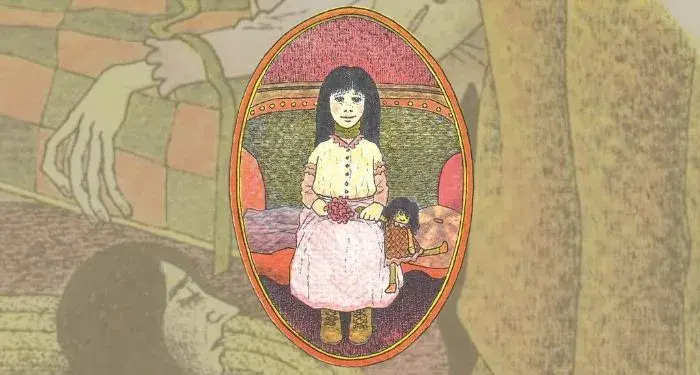Magical Realism, Horror, and Her Body and Other Parties
- Ella Gammel
- Oct 23, 2022
- 3 min read
*Spoilers Ahead for Her Body and Other Parties
What is your favorite fairytale? Beauty and the Beast? The Little Mermaid? The Princess and the Pea? Think before Disney, back to Grimms’ Fairy Tales. More likely than not, your favorite story stems from one where a woman owes a man something. Though not always obvious, this theme frequently presents itself in children’s tales. In Ariel’s original story, she strikes a slightly more gruesome deal with the sea witch: in order to become human, her Prince must marry her or else she will dissolve into sea foam on the day of his wedding to another. Unfortunately, in the original story, the Prince chooses to marry someone else. The only way the mermaid can escape death is to stab the Prince to death; however, when faced with the choice between killing the Prince and dying, she throws herself into the sea and dissolves.
Many of us are culturally numb to a story in which a woman subtly lacks bodily autonomy. Carmen Maria Machado, however, brings this issue to light. In her short story compilation, Her Body and Other Parties, Machado takes hold of fairy tales’ failure to give women bodily autonomy and centers it as her main horror element, using fantastical motifs to accentuate the terror of male entitlement so many of us have forgotten to be afraid of.
Her Body and Other Parties opens with “The Husband Stitch.” This narrative retells the children’s scary story “The Green Ribbon,” a tale from Alvin Schwartz’s 1984 easy reader book In a Dark Dark Room. Schwartz’s story’s protagonist, Jenny, meets and eventually marries a boy named Alfred. From youth to old age, Jenny won’t explain one thing to Alfred: the green ribbon tied around her neck. Jenny never takes the ribbon off, and she won’t tell Alfred why, despite Alfred’s repeated questioning. As she’s dying, Jenny finally tells Alfred that he can take off the ribbon. When he does, Jenny’s head falls off.
On the surface, this is merely a creepy tale. However, further down exists a deeper issue of male entitlement to a woman’s secrets - to her body. Why couldn’t Alfred simply have taken Jenny’s word instead of badgering her about her ribbon for literally her entire life? This true moral - that a man inherently deserves every part of a woman - engrains itself into the hundreds of thousands of children who have read “The Green Ribbon.” Machado purposely pulls this issue to the center of her retelling.
The crux of Machado’s horror is that it’s so close to reality. While “The Husband Stitch” protagonist too has a green ribbon that (surprise) is holding her head on, her relationship with her husband is very true to life. This is where Machado’s magical realism comes into play. The fantasy element of the ribbon drags out the realistic nasty side of the protagonist’s husband. Though the protagonist repeatedly assures the audience he is a “good man,” the husband wants desperately to remove her ribbon, most of all during sex. With this tie to sexual acts, the ribbon, a metaphor for a woman’s deepest sense of self, becomes fetishized. When the narrator finally allows her husband to remove the ribbon (not at the end of her life, only after they’ve sent their son to college), the removal act is deeply sexual. And though the protagonist’s husband never removes her ribbon without her permission, the protagonist gives her final “consent” out of duty and resignation, not because she wants to. “Then, do what you want,” she says. When the protagonist’s head resultantly topples off, we see the end through her eyes: we see her husband’s horrified face, and we feel ourselves falling helplessly to the floor.
Real women likely aren’t struggling with ribbons attaching severed heads. However, male entitlement and forced consent are very real issues that often underscore our daily lives and media without notice. In an age where feminism surrounds us - where the first female VP sits in office; in the after-years of the me-too movement; when every new Disney movie blazes with girlpower - we can easily grow complacent to the micro-misogyny that still very much thrives today: both outside spectators and unwitting victims of this sexism. When the world normalizes smaller acts of aggression, like the husband’s ever-present asking to remove the ribbon, we can convince ourselves that he is indeed a “good man.” Machado’s magical realism, the creeping horror of the ribbon, draws our eyes back to the real horror of her story: male entitlement to the female body.
“The Green Ribbon” is only the first of Machado’s eight creepy, genre-bending tales to brilliantly hold a feminist lens over male entitlement that is otherwise normalized. Her Body and Other Parties is fascinating, haunting, and a beautiful must-read story compilation, both for the deftness of its messaging and for the uniquely creepy pleasures of Machado’s genre-bent fairytale.




Comments